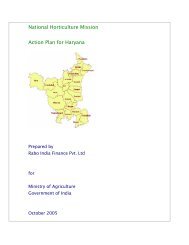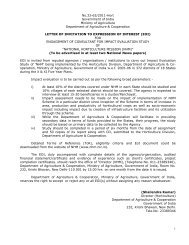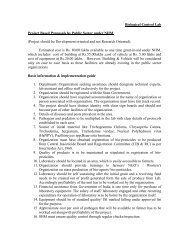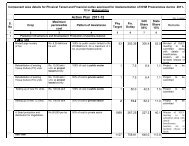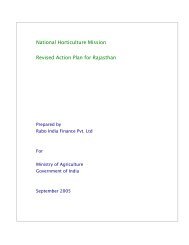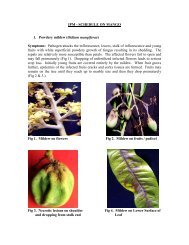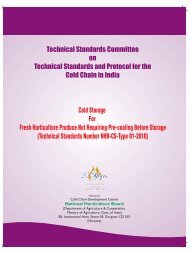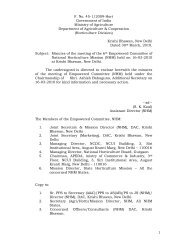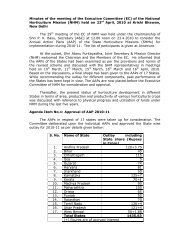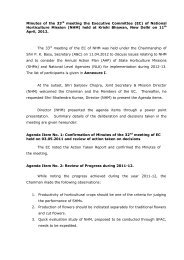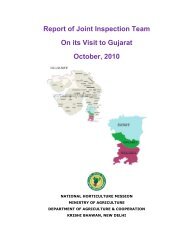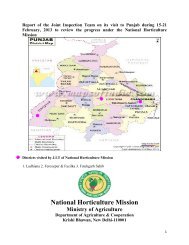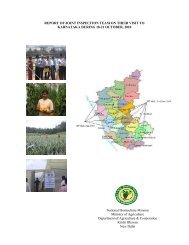Integrated Pest Management Schedule for Vegetables - National ...
Integrated Pest Management Schedule for Vegetables - National ...
Integrated Pest Management Schedule for Vegetables - National ...
Create successful ePaper yourself
Turn your PDF publications into a flip-book with our unique Google optimized e-Paper software.
ud and the grown up larvae migrate and bore fruitcontaminating them with excreta. When the incidenceis high, unopened flower buds swell and harbour theborer. Just be<strong>for</strong>e pupation, the grown up larvae comeout of the fruits and flower buds to pupate in silkycocoons on plant parts or debris.<strong>Management</strong>Use nylon net barrier <strong>for</strong> raising nurseries toeliminate pest incidence coming from nursery tomain field.Cut and destroy wilted insect damaged shoottips during pre-flowering and flowering period atweekly intervals.Regularly destruction of larvae in swollendamaged flower buds and fruits after each harvestis compulsory.Grow all round barrier crops like maize.Practice clean cultivation.Pheromone TrapUse of water traps loaded with pheromone @ 30 /Acrecan reduce the pest incidence to minimum level.Botanical and BioagentsApply neem or pongamia cake @ 250-500 kg/hato ridges at flowering and repeat 2 more times at30-45 days interval.Spray NSPE 4% or neem oil 2% at 10 days interval.Mix Cypermethrin 25 EC (0.75 ml/l) with neemsoap @ 7.5g/ l and spray.SprayBacillus thuringiensis <strong>for</strong>mulation (1%)at weekly interval followed by release ofTrichogramma chilonis @ 2,50,000 /ha (50,000 /release -5 times at weekly intervals, starting fromflowering).Leafhopper (Amrasca biguttulabiguttula Ishida)Both adults and nymphs suck the sap from leaves. Theeggs are inserted into the midrib or veins. On hatchingthe nymphs move along the veins and nymphs suckthe leaf sap. On the older leaves, the damage is seenas yellowish-green mosaic patches followed by brownnecrosis and curling along the leaf margin.<strong>Management</strong>Soil application of neem cake 250 kg/ha followedby sprays of NSPE 4% or neem soap 1% at 10 daysinterval.Spray of systemic insecticides like Dimethoate30 EC @ 2ml/l or Imidacloprid 200 SL @ 0.3ml/l orAcephate 75 SP (1 g/l) at pre-flowering stage.Ash Weevil (Myllocerus subfasciatusGuerin)Ash weevil is an endemic pest feed on the foliage andcause saw teeth like damage along the leaf margin.The adults lay eggs in and around base of the plantsin soil and the hatching grubs feed on roots. Affectedplants wilt and dry up. Wilting is first noticed in patchesin a plot. One can notice very few roots in such wiltingplants when uprooted. Both the roots and plantbase show scraped damage. Grubs pupate in the soilencrustation.Ash weevil damage on brinjal<strong>Management</strong>Soil application of neem cake at the time oftransplanting (@ 250 kg/ha) and repeat the neemcake application <strong>for</strong> 1 or 2 times at 30 and 60 DAP.Epilachna Beetle (Epilachnavigintioctopunctata, Fab.)Both the grubs and the adult beetles scrape the leavesin semi-circular or half moon shaped fashion. Femaleslay torpedo shaped, 15-50 yellowish eggs on theventral surface of leaves. Heavy infestation result inleaf skeletonization. Pupation takes place on the plantitself.INSECT MANAGEMENT/BRINJAL7



